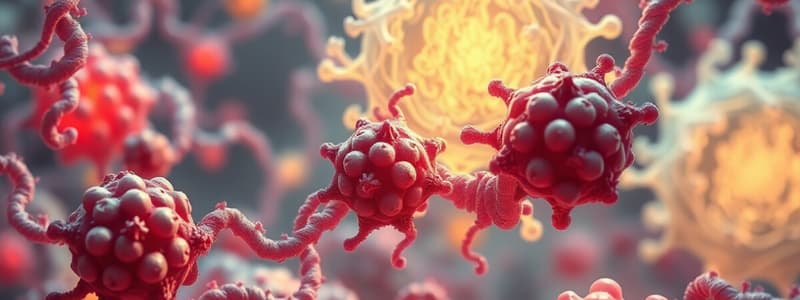Podcast
Questions and Answers
What type of molecule are enzymes?
What type of molecule are enzymes?
- Lipid molecules
- Protein molecules (correct)
- Carbohydrate molecules
- Nucleic acid molecules
Enzymes increase the amount of energy required for a chemical reaction to begin.
Enzymes increase the amount of energy required for a chemical reaction to begin.
False (B)
What is the term for the energy required to start a chemical reaction?
What is the term for the energy required to start a chemical reaction?
activation energy
Enzymes speed up chemical reactions in living organisms by ______ the activation energy.
Enzymes speed up chemical reactions in living organisms by ______ the activation energy.
Match the following enzymes with their primary function.
Match the following enzymes with their primary function.
If an enzyme catalyzes a reaction, what effect does that enzyme have on the reaction?
If an enzyme catalyzes a reaction, what effect does that enzyme have on the reaction?
Enzymes are consumed during the reactions they catalyze.
Enzymes are consumed during the reactions they catalyze.
What name suffix is commonly used for enzymes?
What name suffix is commonly used for enzymes?
The enzyme in saliva that breaks down starch is called ______.
The enzyme in saliva that breaks down starch is called ______.
What is the specific region of an enzyme that binds to a substrate called?
What is the specific region of an enzyme that binds to a substrate called?
An enzyme's active site is rigid and does not change shape when a substrate binds.
An enzyme's active site is rigid and does not change shape when a substrate binds.
What is the name of the reactant that an enzyme binds to?
What is the name of the reactant that an enzyme binds to?
The model of enzyme function where the active site adjusts to fit the substrate is called the ______ model.
The model of enzyme function where the active site adjusts to fit the substrate is called the ______ model.
Which of the following factors can affect enzyme activity?
Which of the following factors can affect enzyme activity?
Increasing the temperature always increases the rate of an enzyme-catalyzed reaction.
Increasing the temperature always increases the rate of an enzyme-catalyzed reaction.
What term describes the loss of an enzyme's structure and function due to extreme conditions?
What term describes the loss of an enzyme's structure and function due to extreme conditions?
Each enzyme has an ______ temperature at which it operates most effectively.
Each enzyme has an ______ temperature at which it operates most effectively.
What happens to an enzyme when the temperature goes far beyond its optimal level?
What happens to an enzyme when the temperature goes far beyond its optimal level?
All enzymes function optimally at the same pH.
All enzymes function optimally at the same pH.
What is the optimal pH for the digestive enzyme pepsin?
What is the optimal pH for the digestive enzyme pepsin?
Enzymes have an ______ pH at which they work best.
Enzymes have an ______ pH at which they work best.
Match the following:
Match the following:
According to the induced fit model, what is the direct result of a substrate binding to an enzymes active site.
According to the induced fit model, what is the direct result of a substrate binding to an enzymes active site.
Enzymes are made of carbohydrates.
Enzymes are made of carbohydrates.
What environmental factors are most likely to cause an enzyme to denature?
What environmental factors are most likely to cause an enzyme to denature?
Flashcards
What are enzymes?
What are enzymes?
Enzymes are protein molecules that speed up chemical reactions in living organisms.
What is activation energy?
What is activation energy?
Energy required to start a chemical reaction.
How do enzymes speed up reactions?
How do enzymes speed up reactions?
Enzymes lower the activation energy of a reaction, allowing it to proceed faster.
What does it mean to catalyze?
What does it mean to catalyze?
Signup and view all the flashcards
What are catalysts?
What are catalysts?
Signup and view all the flashcards
Enzyme naming convention
Enzyme naming convention
Signup and view all the flashcards
What is amylase?
What is amylase?
Signup and view all the flashcards
What is the active site?
What is the active site?
Signup and view all the flashcards
What are substrates?
What are substrates?
Signup and view all the flashcards
What is substrate specificity?
What is substrate specificity?
Signup and view all the flashcards
What is the induced fit model?
What is the induced fit model?
Signup and view all the flashcards
Factors affecting enzyme activity
Factors affecting enzyme activity
Signup and view all the flashcards
Temperature's effect on enzyme activity
Temperature's effect on enzyme activity
Signup and view all the flashcards
What happens when enzymes denature?
What happens when enzymes denature?
Signup and view all the flashcards
Optimal temperature
Optimal temperature
Signup and view all the flashcards
Optimal pH
Optimal pH
Signup and view all the flashcards
What is Pepsin?
What is Pepsin?
Signup and view all the flashcards
Study Notes
- Enzymes for everyone
Enzymes Speed Up Reactions
- Enzymes are protein molecules that accelerate chemical reactions in living organisms
- Enzymes are essential for life because many bodily reactions would be too slow to sustain life without them
Activation Energy
- All chemical reactions need energy to start
- Activation energy is the energy required to start a chemical reaction
- Enzymes work by lowering the activation energy of a reaction
- Reactions occur more quickly since less energy is needed to start them
Catalysts
- An enzyme catalyzes a reaction when it speeds it up
- Enzymes are also called catalysts
Enzyme Names
- Enzyme names typically end in "-ase"
- Amylase is an enzyme present in saliva
- Amylase present in saliva breaks down starch into simpler sugars which simplifies digestion
Enzyme Structure
- An enzyme's active site is the part that binds to the substrate (reactant)
- Substrates are the reactants in an enzyme-catalyzed reaction
- Enzymes are specific to the chemical reactions they catalyze which relates to "substrate specificity"
How Enzymes Work
- Enzymes have a complex three-dimensional surface to which particular reactants (called substrates) fit, like a hand in a glove
- Enzymes and their substrate(s) will bind tightly together, forming an enzyme-substrate complex
- Binding brings key atoms close and stresses key covalent bonds
- A chemical reaction occurs within the active site, which forms the product
- The product separates, freeing the enzyme for further work
Models of Enzyme Function
- Lock and Key Model of enzyme function
- Induced Fit Model of enzyme function
- The induced fit model for how catalysis is more widely accepted
- A conformational or structural change places stress on bonds, causing them to break, which is necessary for creating products
Examples
- Catalase: Converts hydrogen peroxide (H2O2) into oxygen gas and water
- Diastase: Converts starch into maltose
- Pectinase: Converts pectin (in plant cell walls) into simple sugars and releases juices from cells
- Pepsin: Converts protein into short polypeptides
- Rennin: Converts soluble casein (milk protein) into insoluble casein (curdled milk)
Factors Impacting Enzyme Activity
- Temperature and pH influence an enzyme's activity
- Enzyme-catalyzed reactions accelerate with an increase in temperature
- Enzymes begin to denature if the temperature exceeds a specific point, which makes them less effective
- Every enzyme has an optimal temperature at which it works best
- Typical human enzymes work best at about 37°C
- Heat-tolerant organism enzyme works best at approximately 76°C
- Enzymes have an optimal pH at which they work best
- Digestive enzyme, pepsin, works best in the acidic environment of the stomach, pH 2
Studying That Suits You
Use AI to generate personalized quizzes and flashcards to suit your learning preferences.



